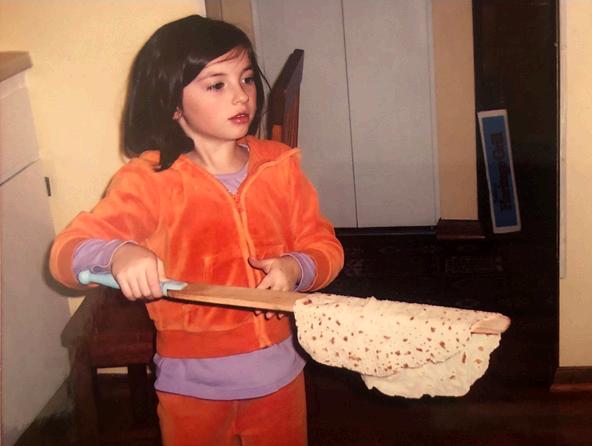
9 minute read
Hemma Hos
Swedish was often spoken by both sets of grandparents, usually when my cousins, sisters and I weren’t supposed to know what was said. My paternal grandparents, Gust and Emma, were first generation immigrants to the U.S. Emma came in 1913 and Gust in 1911. Gust was born in the village of Lillarmsjö about 38 miles west of the city of Umeå on the northeast coast of Sweden. His name was Jonas August and he changed it to Gust when he came to America. Emma Johannsdotter was born in the rural area of Veinge in the south-west of Sweden. My maternal grandparents (Grandma and Grandpa Franklin) were second and third generation Swedish immigrants.
Most of my favorite Swedish memories are of the Swedish food served. My Grandma Emma served heart-healthy food with carrots or raisins mixed into it but no sugar or butter was allowed. “Ät nu!” (eat now!) she said to encourage me to eat. (My Grandma F served lots of sweet butter-filled food.)
However, I survived my Grandma Emma’s cooking and learned about a different Scandinavian food. When I was young, a Norwegian neighbor brought our family some lefse. That was the last time I ate lefse until many years later, when a friend and I took classes on how to make lefse. I have since taught my daughtersin-law, Beth and Nancy. They now have their own griddles, sticks for turning, rolling pins and pastry boards. Beth has had more than one open house for friends to learn how to prepare lefse, and my granddaughter Emily has been making
Treats[ ] à la Karen Gale
Hemma hos
lefse every Christmas since she was five.
My second recipe is ostkaka. This recipe is from my Grandma Franklin’s side of the family. I’ve added some of my own changes to make it easier. In the old way you had to use rennet but I use ricotta cheese. It tastes the same and I love it … hope you do too.
When my husband Robert, of British and Scot descent, was alive, these two dishes were his favorites. Since his recent death these are given to you in honor of him. Enjoy! By Karen Gale
Ostkaka
Karen Gale and her granddaughter. Photo courtesy Karen Gale
Ingredients:
• 15 oz of ricotta cheese • 4 whole eggs • 1/2 tsp salt • 1/2 cup white sugar • 1 tsp vanilla • 1 pint whipping cream.
Preparation:
Beat eggs. Add sugar, salt, vanilla, and cream. Then add cheese. Mix lightly. Dust with nutmeg. Bake in buttered 8 or 9 inch pan at 325 degrees F for about 11/2 hours (after it puffs and the middle doesn't jiggle).
Goes well with raspberries, strawberries, lingonberries or cloudberries.



Lefse
Ingredients:
• 8 cups of Hungry
Jack Potato Flakes put in large bowl
Boil:
• 5 cups of water • 2 Tbs of sugar • 1 Tbs salt • 1/2 cup butter Add to flakes and mix.
Then add:
• 1 cup of half-andhalf cream • 1 cup of whole milk.
Preparation:
Mix all together. Chill covered overnight (or 3 – 4 hours).
To roll out: Use 2 cups of potato mixture to 1/2 cup of flour. Can use hands to mix. Form a ball the size of large golf ball or very small tennis ball and roll out.
Makes about 30 lefse. To freeze, lay 3 stacked lefse flat and place in a gallon size freezer ziplock bag.

Swedish Press Connects [ ] Association of Swedish Teachers and Researchers in America
Swedish at the University of Washington
By Kim Kraft and Amanda Doxtater
In 1909, the activism of three Swedish-Americans resulted in the state legislature passing a law establishing the Department of Scandinavian Studies at the University of Washington. What began as a department consisting of a single faculty member and a handful of students has since grown into one of North America’s largest independent Scandinavian Studies programs offering undergraduate and graduate degrees. A faculty of seven full-time professors and four lecturers research and teach Scandinavian literature, cultural and gender studies, drama and performance studies, film studies, critical race studies, history, politics, and folklore, with language instruction in the Nordic and Baltic languages. Courses highlighting the diversity of the region such as Vikings in Pop Culture and Sexuality in Scandinavia draw over 500 undergraduate students from across campus each quarter, and roughly ten percent earn a major or a minor from the department.
Swedish is the most common language that Scandinavian majors choose to study at the UW. The backbone of the Swedish program at the UW is the Barbro Osher Endowed Chair of Swedish Studies. First held by Ann-Charlotte Gavel Adams and currently by Amanda Doxtater, the program continues a strong tradition of research, building on the work of such prominent scholars as Walter Johnson and Birgitta Steene. Students can study Swedish at levels from beginning to advanced, including courses taught in Swedish on topics such as children’s literature, contemporary fiction, and cinema. The department also offers

Students Kylie Knowles, Justin Chen, and Alicia Moore on a study abroad program in Stockholm. Photo: University of Washington

courses in English on topics such as Swedish Film, Family, The Welfare State, and even IKEA.
UW students study Swedish for many reasons, whether to become closer with Swedish friends, enrich their own heritage, or simply discover their own personal connection to Swedish language and culture. For example, Justin Chen’s curiosity about IKEA and Nordic design inspired him to sign up for first-year Swedish, and he went on to pursue a Swedish minor. As he describes it, “I was introduced to this culture so different from my Asian heritage. Then, my study abroad in Sweden gave me a more native experience of the culture which inspired me to take second year Swedish. I thought the best way to learn a culture was to learn the language.”
Many students appreciate being part of a small departmental community while also being able to enjoy the resources of a large university experience. Senior Alissa Acheson explains: “I wanted a smaller community at the UW and Swedish was a good step towards that. I felt valued and encouraged in the SCAND department! I was also fascinated and interested in learning about the culture, partly because of a family connection, but it blossomed into a genuine interest and curiosity about a culture.” Students and alumni often express that they feel a sense of belonging in the department that lasts even after graduation.
Even in the midst of a pandemic, the UW Department of Scandinavian Studies is committed to creating a welcoming and inclusive learning environment, where our students and faculty appreciate that they’re a part of something larger.
Swedish Press Connects [ ] ‘Many locals now put their hope in the Year of the Oxen’
The Swedish diaspora in Hong Kong: an update

By Ingrid Reinli

The people of Hong Kong are resilient and admirable, having lived through many tough periods in recent decades. Recall SARS 2003; the umbrella protests in 2015; protests against the extradition bill in 2019; the ongoing Covid-19 pandemic; and the most brutal attack yet on the very concept of Hong Kong – the new security law introduced on 30th of June 2020.
The gradual end to One Country, Two Systems, and the conviction that Hong Kong will never be as it once was when things go back to normal post Covid-19, is a reality that more and more people are starting to accept.
As of now, most people in the Swedish diaspora are doing fine; the Swedes follow the changing Covid-19 rules The skyline of Hong Kong. All photos: Hong Kong Tourism Board with their ups and downs. Currently, restaurants close at 6pm, only take-away is possible until 10pm, and table seating is only allowed for 2 people. Most establishments use hard plastic dividers between the tables.
Bars, gyms, beaches, museums, cinemas, public BBQ areas, etc, have reDelicious dim sum can be found in many restaurants in Hong Kong. mained closed for some time. Mask wearing in public areas is mandatory, and any breach can result in a fine of 5,000 HKD (approx 650 USD). One of the few activities that expats as well as locals enjoy now during the cold season is hiking. Hong Kong has many accessible and family friendly country parks to enjoy. The possibility to roam through nature is necessary for mental survival to endure living in small flats.
Some expats have already relocated, as their company’s regional headquarters have moved to Singapore. Others have decided to leave Hong Kong for other reasons. Many Swedes in Hong Kong take the wait-and-see approach. Most expats are concerned for the future of Hong Kong. There have been numerous arrests recently, and many consider the new security law arbitrary and unpredictable.
Suspension of face-to-face classes for most schools continues into February and will not open until earliest after Chinese Lunar New Year, the holiday which begins on February 16th 2021. Many locals now put their hope in the Year of the Oxen, as the Year of the Rat proved to be disastrous in many ways. Online schooling involves a tough change in the every-day life of expat spouses, as children need to be supervised and supported at home during school hours. Play time with friends is also limited to one friend at a time. Fewer people are arriving in Hong Kong on expat contracts, and most exchange students have disappeared. Only people with Hong Kong offers trails aplenty for all levels of hikers. resident ID cards are allowed to enter Hong Kong now, and a 3-week hotel quarantine stay is mandatory. These strict rules force expat workers to conduct their jobs without travelling, instead managing their work online with the help of digital tools and online communication methods. Sham Shui Po is a busy shopping area in Kowloon, Hong Kong. The tighter security has had the result that the protests have largely disappeared. Law and order is back which is something many people do appreciate.
When it comes to the Covid-19 pandemic, Hong Kong is in a much better situation than many other places around the world. At the time of writing this article, the total number of cases in Hong Kong is 9,152, of which 8,307 have already recovered and 155 have died – this in a population of 7,3 million people living in an extremely densely populated area.











